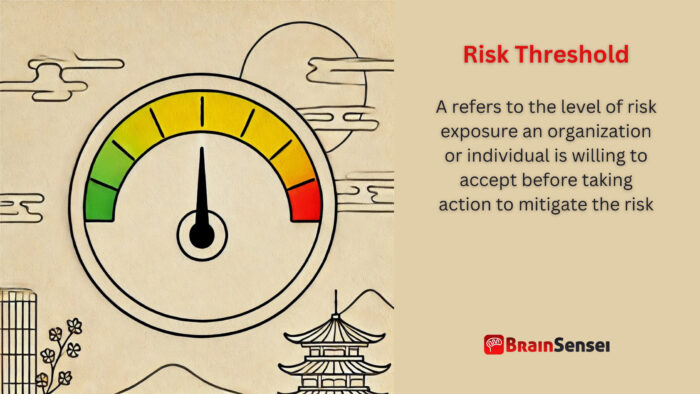
Risk Threshold
What is the Risk Threshold?
The risk threshold is the level of risk exposure an organization or individual is willing to accept before taking action to mitigate the risk. It’s the point at which a risk becomes unacceptable, prompting necessary interventions. Understanding it is essential and empowering for effective risk management. It gives project managers the control to determine which risks to tolerate and which require immediate attention, boosting their confidence in decision-making.
Key Takeaways
- Sets the acceptable risk exposure limit before mitigation is required.
- Varies based on organizational policies, project objectives, and stakeholder risk appetite.
- Helps prioritize risks and make informed decisions in project management.
- Often quantified using probability-impact matrices and other risk assessment tools.
- A lower risk threshold indicates a more risk-averse approach, while a higher threshold allows for greater risk-taking.
Understanding Risk Threshold
How It Works
The project team establishes the risk threshold during project planning. Stakeholder preferences, industry standards, and regulatory requirements influence it. The risk management plan often documents the threshold and aligns with the organization’s overall risk appetite.
For example, a construction project may have a low threshold for safety-related incidents, requiring immediate action for any minor hazard. In contrast, a software development project might have a higher risk threshold for minor coding errors, allowing for some tolerance before implementing corrective measures.
Notes
- Risk threshold varies between projects, industries, and organizational cultures.
- It should be defined early in the project to guide decision-making.
- Must be regularly reviewed and adjusted as project conditions change.
- Aligning risk thresholds with project objectives is crucial. It ensures that risk management is not just a reactive process, but a strategic one that contributes to the project’s success. This connection to the strategic aspect of risk management can make the audience feel more engaged and connected to their projects.
- A clear risk threshold helps avoid unnecessary risk aversion or excessive risk-taking.
Related Terms
- Risk Appetite: The overall level of risk an organization is willing to take in pursuit of its objectives.
- Risk Tolerance: The degree of variation in risk exposure an organization can handle before it impacts project performance.
- Risk Mitigation: Actions to reduce the probability or impact of identified risks.
- Risk Register: A documented list of identified risks, their assessment, and planned responses.
- Risk Exposure: The potential loss or negative impact of a particular risk.
- Probability-Impact Matrix: A tool used to assess and prioritize risks based on their likelihood and potential consequences.
Examples in Various Industries
Construction Industry
A major infrastructure project involves extensive excavation work. The project’s risk threshold for safety incidents is zero tolerance for serious injuries. If they identify a minor hazard, the team immediately act on it to prevent escalation. This proactive approach ensures compliance with safety regulations and minimizes liability.
For instance, suppose a contractor on a bridge construction site notices workers not wearing safety harnesses. Given the zero-tolerance policy for safety violations, the project manager immediately stops work and enforces corrective actions, such as additional safety training and stricter equipment checks. While this may cause short-term delays, it significantly reduces the risk of severe injuries and potential lawsuits.
In another case, consider a high-rise building project where wind speed measurements dictate crane operations. The project has a threshold that restricts crane activity when wind speeds exceed 20 mph. If wind speeds approach this limit, the team immediately halts the operation to prevent potential structural damage or worker injuries. The project team monitors wind conditions in real-time, ensuring that work resumes only when conditions are safe.
Financial Services Industry
A bank implements a risk threshold for cybersecurity breaches. Any vulnerability with a risk probability exceeding 5% requires urgent remediation. They address lower-risk vulnerabilities during regular maintenance cycles. This approach balances security with operational efficiency.
For example, consider a financial institution handling sensitive customer data. Its IT department runs routine vulnerability scans to detect potential security threats. If they find a vulnerability that hackers could exploit with a probability greater than 5%, they immediately patch the system, regardless of the cost. However, if a minor vulnerability has a low likelihood of exploitation, it may be scheduled for resolution during the next system update.
In a real-world scenario, a bank’s internal risk management team detects increased phishing attempts targeting customer accounts. While some attempts have a low probability of success, the bank’s threshold dictates that any cyber threat affecting more than 1,000 accounts in a month warrants a security overhaul. As a result, the bank implements multi-factor authentication and additional security layers to mitigate risks before customers suffer financial losses.
IT and Software Development
A software company sets its risk threshold for system downtime at a maximum of 0.1% per month. If downtime exceeds this limit, the company prioritizes infrastructure upgrades and redundancy measures to maintain service levels.
For example, a cloud service provider guarantees 99.9% uptime for its enterprise customers. If an unexpected server failure causes downtime beyond the established risk threshold, the company activates emergency recovery protocols, such as switching to backup servers. Additionally, it conducts a root cause analysis to prevent future occurrences. This proactive approach helps maintain customer trust and contractual service level agreements.
Another scenario involves a mobile app developer launching a new version of its product. Their risk threshold for software bugs is 2% of active users experiencing critical issues within the first month of release. If reports exceed this limit, the company deploys rapid patches and hotfixes to resolve problems. This approach ensures a smooth user experience while preventing reputational damage.
By clearly defining risk thresholds, organizations across different industries can ensure proactive risk management, minimize losses, and enhance operational efficiency. Failure to manage risk thresholds effectively can lead to increased project costs, missed deadlines, and potential damage to an organization’s reputation.
Use Cases Around the World
United States (Healthcare)
A hospital project team defines a strict risk threshold for medication errors, requiring an automated verification system to flag discrepancies before dispensing medication. This system minimizes patient safety risks and ensures regulatory compliance. By implementing it, the hospital prevents life-threatening errors and improves patient trust.
The system monitors prescription orders in real-time, flagging potential dosage inconsistencies. If an anomaly exceeds the risk threshold, it alerts medical staff for immediate review. Over time, the hospital has reduced medication errors by 30% and enhanced patient care.
Germany (Automotive Manufacturing)
An automotive company in Germany sets a risk threshold for defective parts at 0.5% per production batch. If defects exceed this limit, production halts for quality checks, preventing defective vehicles from reaching customers. The company minimizes recalls and improves brand reputation by maintaining strict quality control.
The company uses AI-driven sensors to detect manufacturing defects in real-time. If the detected defects exceed a threshold, automated systems adjust production processes, reducing waste and improving efficiency.
Japan (Telecommunications)
A telecom provider in Japan establishes a risk threshold for network downtime at 99.99% uptime. Any deviation beyond this threshold requires immediate escalation and remediation to maintain service reliability.
The provider employs predictive analytics to monitor infrastructure health. Automated backups and redundancy measures are activated if the system detects failure risks beyond the acceptable threshold. Maintaining robust uptime standards ensures the provider retains customer trust and a competitive advantage.
Best Practices
Establishing and maintaining effective risk thresholds ensures proactive risk management and adherence to project schedule. Here are some best practices that organizations should follow:
Define it in the Project Lifecycle
The project team should determine risk thresholds during the initial planning phase to ensure they align with the project’s goals, budget, and timeline. Organizations should engage key stakeholders—project sponsors, team members, and clients—to agree on acceptable risk levels. By defining these limits early, teams can set expectations and ensure better decision-making when risks arise.
Align it With Business Objectives
Each project has unique goals and constraints, so risk thresholds should reflect these priorities. For example, a healthcare project may have a zero-tolerance policy for patient safety risks, while a tech startup may accept some degree of software bugs to accelerate product development. Aligning thresholds with business objectives ensures that risk management efforts support overall organizational goals rather than create unnecessary obstacles.
Use Data-Driven Risk Assessments
Organizations should use data analytics, historical project records, and industry benchmarks to establish appropriate risk thresholds. Probability-impact matrices and Monte Carlo simulations can provide valuable insights into risk exposure levels, helping teams quantify risks more effectively. A data-driven approach reduces guesswork and enables objective decision-making.
Implement a Dynamic Risk Monitoring System
Risk thresholds should not be static. As a project evolves, new risks may emerge, requiring adjustments to predefined thresholds. Implementing real-time monitoring systems—such as automated dashboards and predictive analytics—can help teams track risk indicators and take preemptive actions before issues escalate.
Ensure Clear Communication with Stakeholders
Project teams must document and communicate risk thresholds effectively across all levels of the organization. Clear documentation in the risk management plan and regular training and discussions ensure everyone understands when and how to act on risks. This approach is critical in cross-functional teams where different departments may have varying risk tolerance levels.
Establish Contingency Plans for High-Risk Scenarios
Even with clearly defined risk thresholds, unexpected risks can still arise. Organizations should have contingency plans to respond to risks exceeding their thresholds. This could include alternative suppliers in case of supply chain disruptions, backup servers for IT failures, or emergency response protocols for safety incidents. Having these contingency plans ensures business continuity and minimizes disruptions.
Regularly Review and Adjust
Organizations should periodically review risk thresholds based on lessons learned, market conditions, and regulatory changes. Regular risk assessments allow teams to refine their approach and stay agile in managing project uncertainties. For example, a financial institution may adjust its risk thresholds in response to evolving cybersecurity threats or economic downturns.
Balance Risk and Innovation
While managing risks is essential, organizations should avoid being overly risk-averse, which can stifle innovation and project progress. By setting well-defined risk thresholds, teams can take calculated risks that drive business growth while ensuring adequate protection against significant threats. For instance, a pharmaceutical company developing a new drug may set higher risk thresholds during early research stages but lower them significantly during clinical trials.
Leverage Technology for Risk Management
Modern risk management tools, such as artificial intelligence (AI) and machine learning, can help predict potential risks based on historical data. Organizations should incorporate these technologies into risk-monitoring systems to improve accuracy and efficiency. AI-driven tools can help automate risk detection, streamline reporting, and enhance decision-making.
Encourage a Risk-Aware Culture
Embed a proactive risk management culture across all levels of the organization. Employees should be encouraged to report risks without fear of blame, and leadership should support risk management efforts by fostering open discussions on risk-related matters. Training programs, workshops, and scenario-based simulations can help cultivate a risk-aware mindset among teams.
Conclusion: Effective risk management involves setting clear, actionable, adaptable risk thresholds. Organizations can proactively manage risks and ensure project success by defining thresholds early, aligning them with business objectives, leveraging data-driven assessments, and maintaining open communication. Fostering a risk-aware culture, utilizing modern technology, and implementing contingency plans further strengthen an organization’s resilience against uncertainties. Following these best practices ensures that projects remain on track, stakeholders remain informed, and businesses can strike the right balance between risk-taking and control.
Common Mistakes and Issues
A poorly defined risk threshold can lead to project failures, inefficiencies, and increased costs. Here are some common mistakes organizations make regarding risk thresholds:
Setting Unclear or Unrealistic Thresholds
One of the most common mistakes is failing to define risk thresholds clearly. If a project’s risk threshold is too vague, teams may struggle to determine when to take action. For example, suppose a financial institution sets a risk threshold for cyberattacks but does not define what level of threat requires immediate mitigation. In that case, security teams may not act quickly enough, leading to a breach.
On the other hand, setting an unrealistic risk threshold—such as demanding zero risks in a high-risk industry—can hinder progress. For example, an aerospace company that refuses to tolerate any engineering risk may experience excessive delays due to unnecessary overengineering and redundant testing phases.
Inconsistent Risk Thresholds Across Departments
Different departments within an organization may interpret risk thresholds differently, causing inconsistencies in decision-making. If one team tolerates a higher level of risk than another, conflicting priorities can emerge. For example, a marketing team might take risks with aggressive campaigns, while a legal team may enforce highly conservative thresholds, leading to stalled projects and internal conflicts.
Organizations should establish standardized risk thresholds across departments to ensure consistency and alignment with overarching business objectives.
Ignoring Risk Thresholds Once Established
Defining risk thresholds is insufficient—organizations must actively monitor and enforce them. A common mistake is assuming that once thresholds are set, they require no further attention. Risk environments change over time, and failing to update these thresholds in response to new threats can lead to severe consequences.
For example, a manufacturing company may establish a threshold for defective products at 0.5% but fail to update it when new technologies make lower defect rates achievable. The company risks falling behind competitors who implement stricter quality controls by not adjusting the threshold.
Overlooking External Factors That Influence Risk Thresholds
Risk thresholds should account for external factors such as regulatory changes, economic conditions, and technological advancements. Companies that ignore these factors may set inappropriate thresholds that fail to protect their interests.
For instance, a pharmaceutical company operating under strict FDA regulations must adjust its threshold for drug safety based on new compliance requirements. If it fails, it risks legal action and a loss of consumer trust.
Failing to Communicate Risk Thresholds to Key Stakeholders
A risk threshold is only effective if all relevant stakeholders understand it well. Organizations often make the mistake of not communicating thresholds to project teams, suppliers, and partners, leading to confusion and inconsistent decision-making.
For example, suppose an IT company sets a threshold for system downtime at 99.9% uptime but does not communicate this to its cloud service provider. In that case, the provider may not prioritize uptime as required, resulting in unnecessary outages.
Allowing Personal Bias to Influence Risk Thresholds
Decision-makers sometimes allow personal biases to override data-driven risk assessments. For example, a project manager with a history of working on low-risk projects may impose excessively low thresholds on an innovative project, stifling creativity and slowing progress.
Organizations should rely on quantitative risk assessment tools, such as probability-impact matrices and statistical models, rather than personal intuition to prevent this issue.
Neglecting to Review and Update Risk Thresholds Regularly
Risk thresholds must evolve alongside changing business landscapes. Organizations that fail to review and adjust their thresholds may find themselves vulnerable to emerging risks or unnecessarily constrained by outdated limits.
For example, a financial services company may set a threshold for investment losses at 5% per quarter. If market volatility increases due to global economic shifts, maintaining this threshold without reassessment could lead to unnecessary sell-offs and financial losses.
Conclusion: Avoiding these common mistakes is essential for effective risk management. Organizations can improve decision-making, enhance resilience, and mitigate potential project disruptions by setting clear, realistic, and well-communicated risk thresholds. Regular reviews, consistent enforcement across departments, and consideration of external factors help ensure that the thresholds remain relevant and effective in an evolving business environment. When properly managed, risk thresholds are a powerful tool for balancing caution with opportunity, ensuring long-term project success and business sustainability.
Frequently Asked Questions (FAQs)
How is risk threshold different from risk appetite?
The risk threshold is a specific point that requires action when reached, whereas risk appetite represents the willingness to take risks.
Can risk thresholds change during a project?
Risk thresholds should be reviewed and adjusted based on project progress, emerging risks, and stakeholder feedback.
How do organizations determine risk thresholds?
Organizations assess past experiences, industry standards, regulatory requirements, and stakeholder expectations to set it.
Why is risk threshold critical in project management?
It manages risks proactively, preventing delays, cost overruns, and compliance issues.
What tools help define risk thresholds?
Standard tools include probability-impact matrices, risk registers, and Monte Carlo simulations.
Additional Resources
Preparing for a PMI certification?
- Exam Prep Courses: PMP®, CAPM®, and PMI-ACP®
- Exam Simulators: PMP®, CAPM®, PMI-ACP®, PMI-PBA®, PMI-RMP®, PMI-SP®, PgMP®, and PfMP®
- Professional Development Units (PDUs): 15, 30, and 60 PDU Bundles



